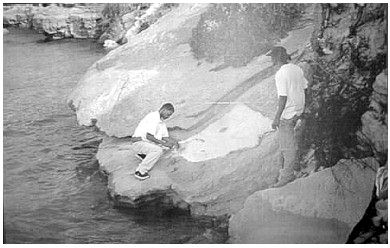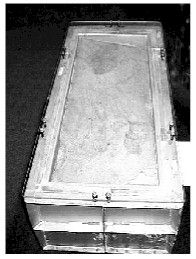|
|
|
WORD FROM THE PRESIDENT

DR. FRANÇOIS DURAND (DEPARTMENT OF ZOOLOGY, RAND AFRIKAANS UNIVERSITY, JOHANNESBURG)
We are still reeling from a spate of new hominid fossil discoveries in South Africa. We had the announcement of Dr André Keyser in December 1998 of his discovery (with two French palaeoanthropologists) at Drie-meulen in the Krugersdorp district, of two juvenile hominid fossils.
Although found a few years earlier, 1998 also saw the removal of the then presumed oldest Homo sapiens footprints from the fossil site at Langebaan, in the Western Cape, to the South African Museum in Cape Town.
But the best of all was the discovery of what seems to be a virtually complete apeman skeleton at Sterkfontein in the Krugersdorp district by Dr Ron Clarke (see South African Journal of Science, 94[10] October 1998).
All three sites are very important for the advancement of world science and our understanding of the origin and evolution of humankind. They remind one yet again what a great privilege it is to be living in a country with such a wealth of fossils.
Dr Dave Roberts of the Belville office of the Council for Geoscience discovered fossilized human footprints on an ancient petrified dune at the Langebaan Lagoon in September 1995. In 1996 he announced the dis-covery of the footprints at the biennial congress of the Palaeontological Society of South Africa. Afterwards he invited Dr Lee Berger of the Palaeoanthropological Research Unit of the University of the Witwatersrand, Johannesburg, to join him in his research on the site. In September 1997 an article on the footprints appeared in National Geographic entitled ‘Tracking the first of our kind’.
Shortly afterwards, it was claimed that inquisitive people put their feet in the fossil tracks (as some of the palaeontologists did when we visited the site as part of the PSSA 1996 con-ference excursion), while visitors reportedly picnicked on the palaeosurface. Therefore to protect the palaeosurface from the public, the responsible scientists proceeded to: drill holes around the area containing the human footprints; cast resin into the holes; cut out the portion containing the human footprints; lift out the block by helicopter and transport it to the South African Museum in Cape Town.
A vast sum was spent on the procedure and a huge rectangular hole was left in the otherwise intact geological formation in a beautiful nature reserve. The excavators did not bother to clean all the resin from the rock, nor did they include in their excavated block a hyena track which lay close to the human footprints. The hyena print now lies abandoned on the palaeosurface, with a congealed blob of resin just missing it. (However, it has since been learnt that casts of the footprints will fill the hole, so hopefully the landscape will in the end be restored for all to appreciate the original geological and geographic context of the find.)
In the glossy alumni magazine of the University of the Witwatersrand, Johannesburg, Arena, the following appeared in January 1998 on page 14: ‘Lee Berger PhD 1994, palaeoanthropologist with Wits’ Department of Anatomical Science, has been named the recipient of the new National Geographic Society Research and Exploration Prize. This is an extremely prestigious award and Lee was flown to the National Geographic world headquarters in Washington, DC to receive the award and prize money of US $ 100 000. The award follows an announcement this year of the discovery of the oldest footprints of an anatomically modern human which Lee and Cape Town geologist Derek Roberts found on the shores of Lange-baan in the Cape. The footprints date back 117 000 years. In the course of directing several field research projects in southern Africa, Lee and his team have discovered numerous fossil specimens and sites rich in evidence of hominids and pre-historic animals. It was for this and future work in this area that the National Geographic believed Lee should be the first recipient of this highly acclaimed award.
‘Lee came to South Africa from the United States in 1989 to do his PhD under Professor Phillip Tobias and now leads the University’s Palaeoanthropology Research Group in the depart-ment of Anatomical Sciences at Wits Medical School.’
The following questions spring to mind:
· Did National Geographic stipulate how their donation had to be spent?
· What exactly did Lee Berger discover at Langebaan?
· Who is ‘Derek’ Roberts anyway?
· Can we now expect Ron Clarke and Dave Roberts to receive money from National Geographic for the much older fossils they have discovered and the more relevant research they are doing?
No retractions, apologies or corrections were printed in any of these newspapers or magazines that I am aware of.
Dave Roberts may have had the last word, though, because he has had tests done on fossil footprints discovered in 1964 in Nahoon in the Eastern Cape. A sandstone block, housed at the East London Museum, also contained human footprints as well as several footprints made by other animals. However, these footprints are clearer and more numerous than those of Langebaan and to top it all they have been dated as being approximately 200 000 years. This makes Roberts’s discovery of the oldest known human footprints in the world, not just slightly older, but almost twice as old as the previous claim. No awards were forthcoming at the time of going to press. "

Making a plaster cast of the footprints (photo: South African Museum display, Cape Town)

The Langebaan fossil footprints, in their protective cask, on display at the South African Museum, Cape Town